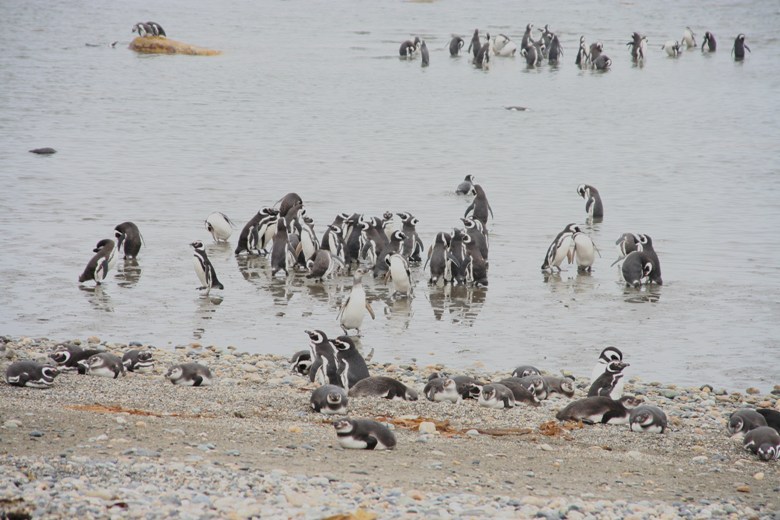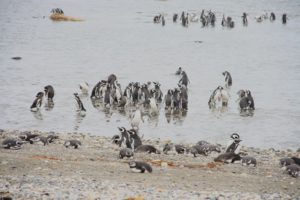DAY TWO: It may be chilly and drizzly but the Penguin families are out for a day at the beach—literally.
We’re in Patagonia, Chile, which required a four-hour flight from Santiago. We overnighted at Puenta Arenas which means “Sandy Point” and was Chile’s first permanent settlement in Patagonia. We don’t see much of the small city because we arrive at the hotel—Hotel Cabo de Hornos (www.hotelaustralis.com) late after a long day of travel and immediately pounce on the pasta buffet before it closes.
So this morning we’re at Turis-Otway, about an hour northwest of Punta Arenas. Many here take a boat to Isla Magdalena to see some of the 120,000 penguins who live at the Monomento Natural Los Pinguinos which, according to Fodor’s is one of the continent’s largest penguin sanctuaries, open only from December to February when the Magellanic penguins come here to nest and nurture their babies along the southern Chilean Coast.
Our schedule didn’t permit the two hour boat trip so we’ve opted for second best and we’re not disappointed, though our guide, Felipe Plasa tells us had we come in the evening, we’d see many more of the picturesque creatures. This reserve stretches over a mile of coastline and is said to be home to over 4,000 Penguins, most of whom are out fishing when we arrive. But those we encounter studiously ignore us, like the cool kids at school, busy with their own cliques. Some cross under the wooden walkway to get from the coast to their burrows. It is an amazing sight that makes us all laugh and smile at their antics. The babies, just a few weeks old when we visit just before New Years, are little gray balls of fur. They don’t have the distinctive white and black coats yet but will in only a couple of months.
These penguins—named for the Spanish explorer Hernando de Maallanes, who spotted them when he arrived here in 1520—are small—just 24 to 30 inches tall and no more than 14 or so pounds. They come here to nest and nurture their young. There is a wooden walkway for a mile or so around the reserve. The penguins waddle by singly and in pairs, as if out for a morning stroll. They gather in the shallow water where the chicks are learning to swim. It reminds me of a scene I’ve been part of many times when my kids were young at community pools—parents gabbing while keeping an eye on the little ones who are splashing nearby. What does all their braying mean? We wonder.
These penguins are very 21st Century families too. The Chicks—born after incubation that lasts no longer than 42 days—are taken care of in shifts by both parents who alternate going out to fish to feed the babies, coming back with sardines, squid, cuttlefish and more. Eagles and other sea birds fly overhead. These penguins, Felipe Plasa tells us, mate for life and return to the same partner year after year as well as to the same nest – “It’s the Penguin’s Hamptons,” jokes my daughter’s boyfriend Dan Foldes. Indeed, this is their summer home where they remain till March and some burrows are so close together that it seems more Miami beach than the Hamptons—a Penguin condo!
When they return to breed in the fall, the male reclaims his burrow and waits there to reconnect with his mate who recognizes him through his call alone. Cool! Though millions of these Penguins still live on the coasts of Chile and Argentina, I learn, they are classified as “Near Threatened” due to their vulnerability to oil spills, as well as predators which prey on the chicks. Climate change is forcing these creatures to swim farther to find food too so they must swim an extra 25 miles or so from their nest for fish. So sad!
I feel so privileged to watch them in their natural habitat—tending their families, yakking with their neighbors, relaxing at the edge of the coast—just like us and our kids at the beach.


